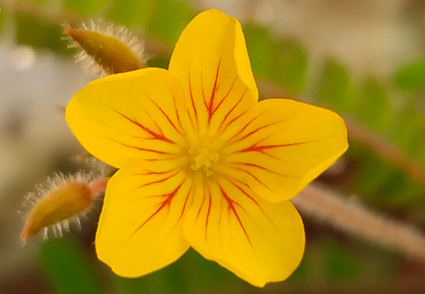Abstract
While revising the family Oxalidaceae for the Western Ghats (SW India), missing typification and nomenclatural issues about several species of Biophytum were noticed. In this contribution, Biophytum intermedium var. pulneyense is reduced to a synonym of B. madurense and neotypes for the names B. madurense and B. intermedium are designated. A brief description, photographs, and taxonomic note on these species are provided to facilitate their identification.
References
- Candolle, A.P. de (1824) Prodromus Systematis naturalis Regni vegetabilis. Treuttel et Würtz, Parisiis, 748 pp. https://doi.org/10.5962/bhl.title.286
- Dassanayake, M.D. (1999) Oxalidaceae. In: Dassanayake, M.D. & Clayton, W.D. (Eds.) A Revised Handbook to the Flora of Ceylon,13. A. A. Balkema, Rotterdam, pp. 177–192.
- Edgeworth, M.P. & J.D. Hooker (1874) Geraniaceae. In: J.D. Hooker (Ed.) The flora of British India 1. L. Reeve & Co., London, pp. 436–437. https://doi.org/10.5962/bhl.title.678
- Fischer, C.E.C. (1938) New or Little-Known Plants from South India: VIII. Bulletin of Miscellaneous information (Royal Gardens Kew) 1938 (1): 32–37. https://doi.org/10.2307/4115467
- Gamble, J.S. (1915) Flora of the Presidency of Madras. Adlard & Son Ltd, London, pp 130–146. https://doi.org/10.5962/bhl.title.21628
- Hiepko, P. (1987) The collections of the Botanical Museum Berlin-Dahlem and their history. Englera 7: 219–252. https://doi.org/10.2307/3776724
- Jisha, D., Kumar, E.S.S., William Decruse, S. & Rajendraprasad, M. (2020) A new species of Biophytum (Oxalidaceae) from the Western Ghats (Kerala, India). Phytotaxa 438 (1): 49–52. https://doi.org/10.11646/phytotaxa.438.1.6
- Jisha, D. (2023) Studies on the Systematics and Phytogeographical affinities of the family Oxalidaceae of Kerala, India. PhD Thesis (unpublished), University of Kerala, Thiruvananthapuram, Kerala, India, 175 pp.
- Khan, A.E.S., Kumar, E.S.S., Binu, S. & Pushpangadan, P. (1998) A new species of Biophytum DC. (Oxalidaceae) from Peninsular India. Rheedea 8: 79–81. https://dx.doi.org/10.22244/rheedea.1998.08.01.05
- Klotzsch, J.F. (1861) Biophytum. In: Peters, W.C.H. (Ed.) Naturwissenschaftliche Reise nach Mossambique 6 (1) (Botanik). pp. 81–85. https://doi.org/10.5962/bhl.title.52323
- Knuth, R.G.P. (1930) Oxalidaceae. In: Engler, A. (Ed.) Das Pflanzenreich Regni vegetabilis conspectus IV. 130 (Heft 95). Wilhelm Engelmann, Leipzig, pp. 1–481. [https://bibdigital.rjb.csic.es/idurl/1/10982]
- Kumar, E.S.S., Suchithra, G.K., Murugesan, K., Namitha, L.H. & Veldkamp, J.F. (2017) Reinstatement and lectotypification of Biophytum poterioides Edgew. (Oxalidaceae)—an endemic species of the Peninsular India. Abrahamia 3: 16–19.
- Linnaeus, C. (1753) Species Plantarum 1. Salvius, Stockholm, 560 pp. https://doi.org/10.5962/bhl.title.7081
- Lourteig, A. (1980) Oxalidaceae. Flora of Panama. Annals of the Missouri Botanical Garden 67 (1): 826–834. https://doi.org/10.2307/2398968
- Manna, M.K. (1997) Oxalidaceae. In: Hajra, P.K., Nair, V.J. & Daniel, P. (Eds.) Flora of India 4. Botanical Survey of India, Calcutta, pp. 241–255.
- Matthew, K.M. (1981) Materials for a Flora of the Tamilnadu Carnatic. Rapinat Herbarium, Tiruchirapalli. Nayar, T.S., Beegam, R.A. & Sibi, M. (2014) Flowering Plants of the Western Ghats, India, 1. Jawaharlal Nehru Tropical Botanic Garden and Research Institute, Palode, 934 pp.
- Sauliere, A. (1914) Plants from the Pulney Hills. St Joseph's Industrial School Press, Trichinopoly (Tiruchirapalli), India, 9 pp.
- Thiers, B. (2024 [continuously updated]) Index Herbariorum: a global directory of public 22 herbaria and associated staff. New York Botanical Garden’s Virtual Herbarium. Available from: http://sweetgum.nybg.org/science/ih/ (accessed 18 June 2024)
- Trimen, H. (1893) A hand-book to the Flora of Ceylon 1 and Atlas. Dulau, London, 327 pp. and 100 plates. https://doi.org/10.5962/bhl.title.10864
- Thwaites, G.H.K. (1858) Enumeratio plantarum Zeylaniae. Dulau & Co., London, 483 pp. https://doi.org/10.5962/bhl.title.574
- Turland, N.J., Wiersema, J.H., Barrie, F.R., Greuter, W., Hawksworth, D.L., Herendeen, P.S., Knapp, S., Kusber, W.-H., Li, D.-Z., Marhold, K., May, T.W., Mcneill, J., Monro, A.M., Prado, J., Price, M.J. & Smith, G.F. (Eds.) (2018) International Code of Nomenclature for algae, fungi, and plants (Shenzhen Code) adopted by Nineteenth International Botanical Congress Shenzhen, China, July 2017. Regnum Vegegetabile 159. Koeltz Botanical Books, Glashütten. https://doi.org/10.12705/Code.2018
- Veldkamp, J.F. (1971) Oxalidaceae. In: van Steenis, C.G.G.J. (ed.) Flora Malesiana 7 (1). Bogor, Indonesia, pp. 151–178. https://doi.org/10.5962/bhl.title.40744
- Wheeler, L.C. (1983) Citation of the Nineteenth century specimens in the herbarium at Peradenia. Ceylon Journal of Science, Biological Science 16 (1–2): 58–64.
- Wight, R. (1840) Illustrations of Indian Botany, 1. J. B. Pharoah, Madras., 218 + XXI pp.
- Zuccarini, J.G. (1832) Monographie der amerikanischen Oxalis-Arten. Abhandlungen der Mathematisch-Physikalischen Classe der Königlich Bayerischen Akademie der Wissenschaften. Munich 1: 177–276.


